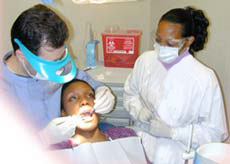Reducing Bloodborne Pathogens Exposure in Dentistry:
An Update -- Page 1
Reducing bloodborne pathogen exposures helps provide a safe and healthful workplace for dental employers and employees. In addition, reducing exposures can help reduce costs and increase productivity and employee morale.
California code of regulations, title 8 (8 CCR), bloodborne pathogens section 5193 (c) (1), requires each employer having employee(s) with occupational exposure (faq #3 and faq #4) to eliminate or minimize employee exposures to bloodborne pathogens. Bloodborne pathogen exposures must be reduced by establishing, implementing, and maintaining an effective exposure control plan (see page 2). An employer's exposure control plan must include effective procedures for identifying and selecting appropriate, currently available engineering controls for the work tasks employee(s) perform. In addition to other requirements, contaminated sharps shall not be bent, recapped or removed from devices except when the procedure is preformed using a mechanical device or a one-handed technique, and the employer can demonstrate that no alternative is feasible, or that such action is required by a specific dental procedure.
Engineering Controls
Engineering controls isolate, remove or reduce the bloodborne pathogen hazard from the workplace. Examples of engineering controls
include sharps with engineered sharps injury protection (ESIP) and sharps disposal containers.

ESIP means either (1) a physical attribute built into a needle device used for withdrawing body fluids, accessing a vein or artery, or administering medications or other fluids, which effectively reduces the risk of an exposure incident by a mechanism such as barrier creation, blunting, encapsulation, withdrawal, or other effective mechanisms; or (2) a physical attribute built into any other type of needle device or into a non-needle sharp, which effectively reduces the risk of an exposure incident. Remember, for a device to qualify as ESIP, the anti-stick safety feature must effectively reduce the risk of an exposure incident. This depends on factors that include, but are not limited to, the design of the device, its ability to perform as intended by the design, the appropriateness of the device for a particular application.
Contaminated sharps must be placed immediately (or as soon as possible after use) in sharps disposal containers. Sharps containers must be labeled and easily accessible to employees. They must be located as close as feasible to the immediate area where the sharps are used or can be reasonably anticipated to be found (e.g., dental operatories)(faq #49 and faq #50). Sharps containers must be:
- rigid
- closeable and sealable
- puncture resistant
- leak proof
- portable
- kept in an upright position
- closed immediately prior to their removal or replacement
- placed in a secondary container if leakage is possible
- replaced as needed to prevent overfilling.
ESIP must be used to reduce or prevent exposures to bloodborne pathogens except in circumstances where the employer can demonstrate that the ESIP device:
- Is not available in the marketplace
- Jeopardizes the patient's safety or the success of a dental procedure as determined by the dentist or their professional staff
- Is not more effective than the control currently in use; or
- Lacks the necessary safety performance information. This means that the employer must:
- demonstrate that reasonably specific and reliable information on the safety performance of this particular engineering control is not available, and
- actively determine by means of objective product evaluation criteria whether the use of the engineering control will reduce the risk of exposures. For more information on the exceptions to the use of engineering controls see the following:

